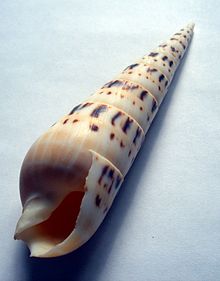

A siphonal notch is a feature of the shell anatomy in some sea snails, marine gastropod mollusks.
In these particular groups of sea snails the animal has a soft tubular anterior extension of the mantle called a siphon through which water is drawn into the mantle cavity and over the gill and which serves as a chemoreceptor to locate food. This siphonal opening also serves for the exit of the water that has entered by the branchial opening.
The siphonal notch is a noticeable notch situated at the most posterior part of the aperture of the shell, through which the siphon is extended when the animal is active. The notch at the posterior end of the aperture is also called the anal notch, anal sinus, anal canal or posterior canal.
Instead of a simple siphonal notch, some gastropods have an elongated siphonal canal, a hard shell tube which extends out from the anterior edge of the aperture.
See also[edit]
References[edit]
Well, that’s interesting to know that Psilotum nudum are known as whisk ferns. Psilotum nudum is the commoner species of the two. While the P. flaccidum is a rare species and is found in the tropical islands. Both the species are usually epiphytic in habit and grow upon tree ferns. These species may also be terrestrial and grow in humus or in the crevices of the rocks.
View the detailed Guide of Psilotum nudum: Detailed Study Of Psilotum Nudum (Whisk Fern), Classification, Anatomy, Reproduction